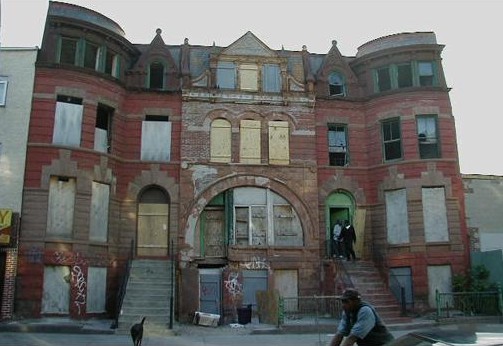Here Comes the Bank, There Goes Our Neighborhood – How “Lenders” Discriminate in the Treatment of Foreclosed Homes
EXECUTIVE SUMMARY
Discriminatory practices rampant in America’s housing market have driven our nation’s foreclosure crisis. Already, a robust body of research has revealed that African-American and Latino borrowers received a disproportionate share of highcost subprime loans, often when they qualified for better, more sustainable loans. Further research demonstrates that foreclosures are not evenly distributed throughout our country’s neighborhoods, but rather are excessively concentrated in communities of color.
This report examines the differing ways in which financial institutions treat the foreclosed properties that they own depending upon the racial composition of the neighborhood in which the properties are located. These bank-owned properties are known as real estate owned, or REO, properties.
An investigation of REO properties in four metropolitan areas demonstrated that banks often maintain REO properties that are located in White and some racially and ethnically integrated census tracts better than properties located in predominately African-American and Latino neighborhoods in the same metropolitan area.
This investigation was conducted by the National Fair Housing Alliance and three of its members – the Connecticut Fair Housing Center in Hartford, Connecticut, the Miami Valley Fair Housing Center in Dayton, Ohio, and Housing Opportunities Made Equal in Richmond, Virginia. Staff from the fair housing organizations visited a total of 624 bank-owned properties and evaluated their exterior condition on a 100-point scale to determine whether or not banks and their third-party contractors were taking necessary steps to equally maintain the properties they owned.
The results demonstrate a stark disparity: in three of the four metropolitan areas, banks maintained properties located in White or in the case of Montgomery County, MD, stably integrated neighborhoods in a substantially better manner than they maintained properties located in African-American and Latino neighborhoods. While REO properties in White neighborhoods were more likely to have well-maintained lawns, secured entrances, and professional sales marketing, REO properties in African-American and Latino neighborhoods were more likely to have poorly maintained yards, unsecured entrances, look vacant or abandoned, and have poor curb appeal.
- Connecticut: Between June 2009 and June 2010, NFHA estimates 1,899 Real Estate Owned properties were on the market in Hartford, Connecticut and New Haven, Connecticut. In this region, REO properties in white neighborhoods scored 89 out of 100 points, properties in Black neighborhoods scored 78 points, and properties in Latino areas scored 66 points.
- Maryland: Between June 2009 and June 2010, NFHA estimates 3,979 Real Estate Owned properties were on the market in Montgomery County, Maryland and Prince George’s County, Maryland. Montgomery County is a rare example of a racially and ethnically integrated suburb, while Prince George’s County is a majority African-American suburb. In this region, REO properties in well-integrated neighborhoods scored 92 out of 100 points, while properties in Black neighborhoods scored 81 points.
- Ohio: Between June 2009 and June 2010, NFHA estimates 2,117 Real Estate Owned properties were on the market in Montgomery County. In this region, REO properties in white neighborhoods scored 72 out of 100 points, while properties in Black neighborhoods scored 64 points.
- Virginia: Between June 2009 and June 2010, NFHA estimates 2,804 Real Estate Owned properties were on the market in Chesterfield, Henrico, and Richmond Counties in Virginia. While the study of the selected properties did not demonstrate the racial disparity found in other regions, the overall maintenance of the properties by the banks was inadequate. REO properties in white neighborhoods scored 79 points out of 100, while properties in Black neighborhoods scored 83 points.
The federal Fair Housing Act requires banks and servicers to maintain and sell properties they own without regard to the race or national origin of residents living in the area in which the property is located. A bank risks violating civil rights laws if it owns a home in an African-American or Latino neighborhood and fails to take the same steps to maintain, market, and sell it as it would take for a home in an area with a largely White population. Moreover, differing treatment of neighborhoods damages those neighborhoods, prevents neighborhood stabilization and economic recovery, and harms investors by unnecessarily depressing the property value of the REO asset.
In order to ensure an equal opportunity for neighborhood stabilization and recovery and reduce the racial disparities of the foreclosure crisis, it is imperative that banks take affirmative steps to maintain, market, and sell all REO properties according to fair housing best practice standards. It is also imperative that federal regulators and enforcement agencies examine the ways in which banks and the vendors that they hire conduct this business. Lastly, it is imperative that local municipalities and residents remain vigilant and ensure that the concentration of REO properties is not impeding fair housing choice.
SOURCE: National Fair Housing Alliance
Full report below…
~
4closureFraud.org
~


what a total disgrace that these homeowners were targeted!
the architecture of building at the top is beautiful. can you imagine what that building would look like if it were restored?
and the neighborhood with all of the charming cottages that are now boarded up —- it’s criminal!
Please look at a draft proposed legislative agenda here:
foreclosuredefensealliance.us
or ask me to email it to you so we can act at the grassroots level to take these properties back from the BANKSTERS through seizure and forfeiture laws involving unpaid fines for code violations.
mlfwf@yahoo.com